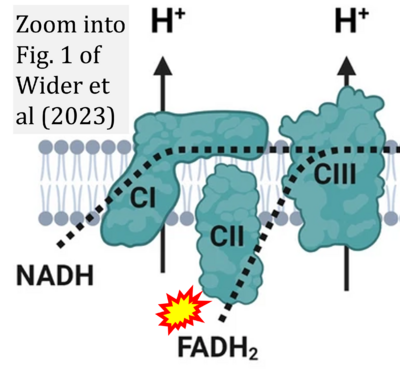Difference between revisions of "Wider 2023 Crit Care"
(Created page with "{{Publication |title=Wider JM, Gruley E, Morse PT, Wan J, Lee I, Anzell AR, Fogo GM, Mathieu J, Hish G, O’Neil B, Neumar RW, Przyklenk K, Hüttemann M, Sanderson TH (2023)...") |
|||
| Line 14: | Line 14: | ||
|editor=Gnaiger E | |editor=Gnaiger E | ||
}} | }} | ||
[[File:Wider 2023 Crit Care CORRECTION.png|right|400px]] | [[File:Wider 2023 Crit Care CORRECTION.png|right|400px]] | ||
{{Template:Correction FADH2 and S-pathway}} | {{Template:Correction FADH2 and S-pathway}} | ||
Latest revision as of 00:44, 19 December 2023
| Wider JM, Gruley E, Morse PT, Wan J, Lee I, Anzell AR, Fogo GM, Mathieu J, Hish G, O’Neil B, Neumar RW, Przyklenk K, Hüttemann M, Sanderson TH (2023) Modulation of mitochondrial function with near-infrared light reduces brain injury in a translational model of cardiac arrest. Crit Care 27:491. https://doi.org/10.1186/s13054-023-04745-7 |
Wider JM, Gruley E, Morse PT, Wan J, Lee I, Anzell AR, Fogo GM, Mathieu J, Hish G, O’Neil B, Neumar RW, Przyklenk K, Hüttemann M, Sanderson TH (2023) Crit Care
Abstract: Background: Brain injury is a leading cause of morbidity and mortality in patients resuscitated from cardiac arrest. Mitochondrial dysfunction contributes to brain injury following cardiac arrest; therefore, therapies that limit mitochondrial dysfunction have the potential to improve neurological outcomes. Generation of reactive oxygen species (ROS) during ischemia-reperfusion injury in the brain is a critical component of mitochondrial injury and is dependent on hyperactivation of mitochondria following resuscitation. Our previous studies have provided evidence that modulating mitochondrial function with specific near-infrared light (NIR) wavelengths can reduce post-ischemic mitochondrial hyperactivity, thereby reducing brain injury during reperfusion in multiple small animal models.
Methods: Isolated porcine brain cytochrome c oxidase (COX) was used to investigate the mechanism of NIR-induced mitochondrial modulation. Cultured primary neurons from mice expressing mitoQC were utilized to explore the mitochondrial mechanisms related to protection with NIR following ischemia-reperfusion. Anesthetized pigs were used to optimize the delivery of NIR to the brain by measuring the penetration depth of NIR to deep brain structures and tissue heating. Finally, a model of out-of-hospital cardiac arrest with CPR in adult pigs was used to evaluate the translational potential of NIR as a noninvasive therapeutic approach to protect the brain after resuscitation.
Results: Molecular evaluation of enzyme activity during NIR irradiation demonstrated COX function was reduced in an intensity-dependent manner with a threshold of enzyme inhibition leading to a moderate reduction in activity without complete inhibition. Mechanistic interrogation in neurons demonstrated that mitochondrial swelling and upregulation of mitophagy were reduced with NIR treatment. NIR therapy in large animals is feasible, as NIR penetrates deep into the brain without substantial tissue heating. In a translational porcine model of CA/CPR, transcranial NIR treatment for two hours at the onset of return of spontaneous circulation (ROSC) demonstrated significantly improved neurological deficit scores and reduced histologic evidence of brain injury after resuscitation from cardiac arrest.
Conclusions: NIR modulates mitochondrial function which improves mitochondrial dynamics and quality control following ischemia/reperfusion. Noninvasive modulation of mitochondria, achieved by transcranial treatment of the brain with NIR, mitigates post-cardiac arrest brain injury and improves neurologic functional outcomes.
• Bioblast editor: Gnaiger E
Correction: FADH2 and Complex II
- FADH2 is shown as the substrate feeding electrons into Complex II (CII). This is wrong and requires correction - for details see Gnaiger (2024).
- Gnaiger E (2024) Complex II ambiguities ― FADH2 in the electron transfer system. J Biol Chem 300:105470. https://doi.org/10.1016/j.jbc.2023.105470 - »Bioblast link«


